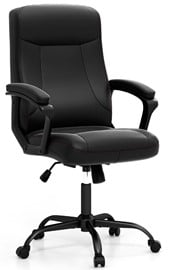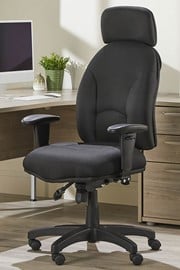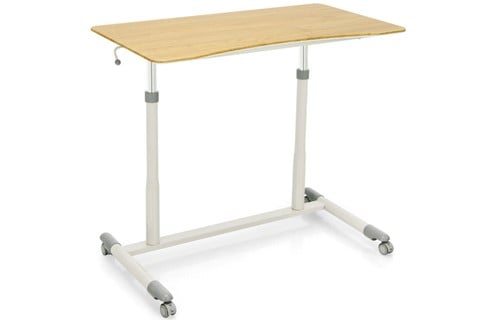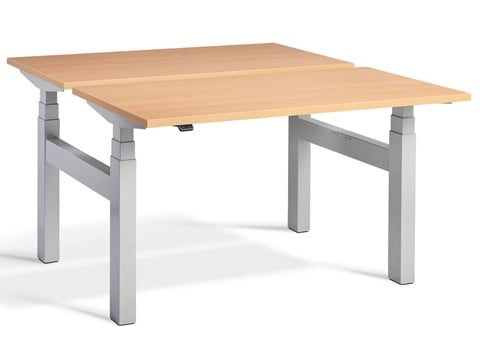10 of The Best Desk Stretches To Do In The Office
It’s a well-known fact that sitting for too long can wreak havoc on our bodies. For most office workers, we don’t have much choice. Our 9 to 5 jobs require us to be sat at our computer desks and with years of this routine, the toil can start to set in on our overall health.
For many of us, we don’t consciously think about how long we’ve been sitting for, or even if we’ve moved much in the past hour. Our lack of variation in our movements while sat helps contribute to aches and pains.
Have you ever considered if you’re sitting correctly? It seems like such a mundane topic, but not sitting correctly can have awful repercussions as time goes on. It was found that 78% of UK professionals have or had trouble with backache, knee pain and even repetitive strain injury (RSI). An all too common trend that can be remedied with some simple but effective daily stretching (or sometimes referred to as "deskercise").
Top Tips Before Starting Your Desk Stretches
- Set an alarm to go off every 45 to 60 minutes to help remind you to stretch
- Hold each stretch for at least 15 seconds
- Avoid any exercise that may cause pain or discomfort
- Breath normally when stretching - try not to hold your breath
- Build a stretching routine that targets the entire body
1. Chest Stretch
Position: Seated or Standing
Hunching over our desk or laptop can cause significant discomfort in our chest and shoulders.
How to: Position your arms behind you and interlace your fingers. Straighten your arms and slowly lift your hands a few inches until you feel the stretch in your chest. Hold this for 10 to 30 seconds and then relax.
Alternative: Interlace your fingers and position them behind your head with your palms facing forward. Gently squeeze your shoulder blades together and move your elbows and hands backwards. Vary the height of your hands to produce a slightly different stretch.
2. Shoulder Shrug
Position: Seated or Standing
Shoulder shrugs are a popular choice due to the ease of performing them and are ideal for any muscle tension in your neck, shoulders and upper back.
How to: Place your feet shoulder-width apart with your arms at your side. If you’re standing, slightly bend your knees. Keep your chin up and head looking straight ahead. As you breathe in, slowly raise your shoulders high up towards your ears. Lower your shoulders as you breathe out and aim to repeat this for 3 sets of 10 repetitions.
3. Upper Back Stretch
Position: Seated or Standing
While the shoulder shrug should help get your circulation going, this upper back stretch will help work out any tension between your shoulder blades.
How to: Stretch out both arms and rotate your hands so that the palms are facing away from one another. Slowly cross your arms and press your palms together. Contract your abs and round your back as though you’re curving over an imaginary ball. Reach away and relax your head.
4. Spinal Twist
Position: Seated
This stretch is to be done very slowly in order to make sure you don’t overstretch. This stretch is ideal for any lower back tension from a day of sitting for prolonged periods.
How to: Sat in your ergonomic office chair, plant your feet flat on the ground, shoulder-width apart. Contract your abs and gently rotate to the right and use the arm of the chair to help deepen the stretch. Repeat this process for the left side.
5. Tall Torso Stretch
Position: Seated or Standing
Hunched over your laptop all day will undoubtedly cause aches and pains. Release that pain with this simple and relaxing stretch.
How to: Lace your fingers together and stretch up towards the ceiling as you take a big deep breathe in. Hold this position for a few seconds and then release your breath as you sweep the arms back down by your side. Repeat this stretch 8 to 10 times.
6. Mouse Pain Forearm Stretch
Position: Seated or Standing
You can build up a surprising amount of tension within the forearms from typing and using a mouse all day. Practice this stretch often to help prevent the onset of a repetitive strain injury.
How to: Stretch out your right arm and turn your palm to face the ceiling. Using your left hand, gently pull back your fingers so they point toward the floor. Be careful not to overstretch this muscle. Hold softly for 10 to 30 seconds and then repeat on the other hand.
7. Neck Stretch
Position: Seated
A build-up in tension in your neck can lead to a variety of discomfort. Most notably is tension headaches, and this is an all too common occurrence for office workers. Relieve your neck tension with the following stretch.
How to: Sit with your feet flat on the ground. Grab the right side of your seat with your right hand and gently tilt your head to the left. Attempt to pull your seat upwards and you should feel the stretch side the right side of your neck. Hold this stretch for 10 to 30 seconds and repeat on the left side.
8. Hip Flexor Stretch
Position: Standing
Sitting puts a lot of pressure on your hips and stretching is a good way to release it. Perform this stretch multiple times a day in the office and you’ll feel so much better for it.
How to: Do this stretch while standing. Place your right leg back a few feet and bend at the knee, similar to a lunge position. Lower both knees and squeeze at your back leg’s glutes and hold for a deep stretch. Repeat this again for the left leg.
9. Seated Hip Stretch
Position: Seated
Another stretch for your hips, but this time you will be seated. A perfect stretch for any form of prolonged sitting which can be performed within minutes.
How to: Place your right ankle over your left knee. Sit up tall and straight then slowly lower your torso towards your knee to perform the stretch. Hold this position for 10 to 30 seconds then repeat for the opposite leg.
10. Inner Thigh Stretch
Position: Seated
Our last stretch for this routine is again seated and it builds on the previous stretch we just performed.
How to: Make sure you have enough room in front of you as you position your feet flat on the ground and wider than your shoulders. Keep your back straight and place your elbows on the inside of your thighs. Gently push your thighs out with your elbows and keep your abs contracted. Hold this for 10 to 30 seconds.
Ergonomic Office Furniture
It’s not just sitting correctly and stretching that can help you beat any unwanted aches and pains. Office furniture can play a big part in prevention, with specific gear scientifically made to combat issues that may arise from years of office work.
Ergonomic Office Chairs
Ergonomic is a science. It is a discipline that involves looking at how objects (such as office chairs) can be designed in such a way to help compliment easy and safe use with human interaction.
Sitting down causes a number of stresses on our bodies, and to be frank, our bodies were not designed for our sedentary modern lifestyles.
But with the right tools, we can help prevent lasting damage on our bodies and this is where an ergonomic office chair comes into play.
For the complete rundown on what an ergonomic office chair is, please read our “Ergonomics of a Chair Explained” article.











